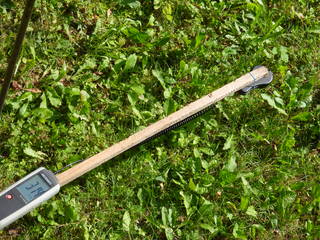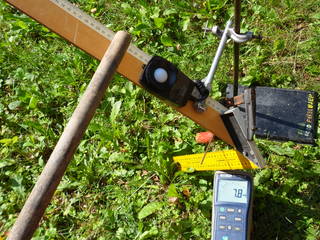| Name | Last modified | Size | Description | |
|---|---|---|---|---|
| Parent Directory | - | |||
| tosun_sunlit.jpg | 2012-06-21 15:26 | 6.8M | ||
| tosun_shadow.jpg | 2012-06-21 15:26 | 6.9M | ||
| sunlit.jpg | 2012-06-21 15:28 | 5.5M | ||
| shadowed.jpg | 2012-06-21 15:28 | 5.5M | ||
| configuration.jpg | 2012-06-21 15:28 | 4.7M | ||
| visual_down.jpg | 2012-06-21 16:00 | 5.4M | ||
| visual_up.jpg | 2012-06-21 16:00 | 5.5M | ||
| solar_down.jpg | 2012-06-21 16:05 | 6.4M | ||
| solar_up.jpg | 2012-06-21 16:05 | 6.3M | ||
| char_down.jpg | 2012-06-24 14:59 | 4.8M | ||
| char_up.jpg | 2012-06-24 15:00 | 4.7M | ||
| 320/ | 2013-01-14 23:41 | - | ||




Verifying lambertian (cosine) sensitivity of a luxmeter sensor. Configuration
at 0.1 rad ‘angular height’ (84.3° from normal incidence).
Two details of measurement. The stick casting a shadow onto the sensor
is to be held just a bit shifted when the sensor is in sunshine, to block a
piece of the sky close to sun – this way, the bias is minimised:



Direct oblique sunshine, as apparent, is (18.1-7.8=10.3) klx.
A and an analogous measurement at normal incidence, using a hand to cast
the needed shadow:


Direct normal sunshine, as apparent, is (101.5-14.7=86.8) klx. In the
preceding, oblique case at (π/2 - 0.1) rad,
it should be 10× less, but it is not so little. We may guess that
the sensor reports some 1.2× larger signal than it should, at this
oblique direction.
Would it do any problem? For scenes of uniform luminance, the relative amount of light from such a direction, which is very far from a perpendicular one, is little anyway. The integral of effective space angle from 0 to x=π/2 - 0.1 is pi*(1-cos(2*x))/2 = ~3.110, just 1 % less then π. A 20 % error in the measurement of such extremely obliquely incident light can be mostly neglected. Of course, less oblique directions are more important and are to be inspected in a similar way.